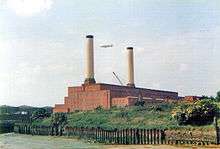Brunswick Wharf Power Station
| Brunswick Wharf Power Station | |
|---|---|
 Brunswick Wharf Power Station in 1984 | |
 Location of Brunswick Wharf Power Station in Greater London | |
| Country | England |
| Location | Tower Hamlets, London |
| Coordinates | 51°30′29″N 0°00′04″E / 51.5081°N 0.0010°ECoordinates: 51°30′29″N 0°00′04″E / 51.5081°N 0.0010°E |
| Commission date | 1952 |
| Decommission date | 1984 |
| Operator(s) |
British Electricity Authority, Central Electricity Generating Board |
| Thermal power station | |
| Primary fuel | coal |
| Tertiary fuel | oil |
| Power generation | |
| Units operational | six turbo-alternators |
| Make and model | Metropolitan-Vickers |
| Nameplate capacity | 340 MW |
| grid reference TQ388807 | |
Brunswick Wharf Power Station (also known as Blackwall Power Station) was a coal- and oil-fired power station on the River Thames at Blackwall in London. The station was built by Poplar Borough Council for the British Electricity Authority (BEA) after the Second World War.[1]
History
The station was built in stages between 1947 and 1956[1] on the site of the former East India Export Dock, itself originally the Brunswick Dock of the Blackwall Yard shipyard. The site was controversial due to both potential air pollution in a densely populated part of London, and to the implications of further concentrating generating capacity in an area that had been a strategic target in The Blitz.[1]
The building was a monumental brick structure with fluted concrete chimneys, similar to Gilbert Scott's design for Battersea Power Station. Its main building contractor was Peter Lind & Company with Redpath Brown & Company supplying the steelwork, Tileman and Company building the reinforced concrete chimneys and Marples, Ridgeway and Partners being the main civil engineering contractors.[1] Metropolitan-Vickers supplied the six turbo-alternators and Clarke, Chapman & Company and John Brown & Company supplied the 11 boilers.[1] A new 855 feet (261 m) concrete wharf with three Stothert & Pitt luffing cranes was built to land coal brought by colliers.[1]
The first phase of the station was supposed to be commissioned in 1948 but in fact did not start supplying electricity until 1952.[1] The station was officially opened by BEA chairman Walter Citrine, 1st Baron Citrine in 1954 but was not completed until 1956.[1] In 1957 the alternators were uprated to produce a total of 118 MW.[1] The final configuration of the station was 4 x 55 MW generators and 2 x 60 MW hydrogen cooled generators. Eleven boilers were installed.
The station was originally coal-fired, but the BEA's successor, the Central Electricity Generating Board, had it converted to oil in 1970–71.[1] The conversion to oil included the first solid state furnace controls in the UK, installed by Associated British Combustion, of Portchester UK. Associated British Combustion was subsequently in financial trouble and was acquired by Combustion Engineering of USA.[2] The CEGB planned to enlarge the station, but the 1973 oil crisis increased the price of oil, and the CEGB found it had surplus generating capacity.[1] The CEGB therefore decommissioned the station in 1984[1] and sold it in 1987.[1] The power station was demolished in 1988–89, with the exception of the switchgear house, which survived until the 1990s[1] but was later redeveloped.[3] Three blocks called Elektron Towers and a block called Switch House have been built on the site of the power station.[4][5]
References
- 1 2 3 4 5 6 7 8 9 10 11 12 13 14 Hobhouse, Hermione, ed. (1999) [1994]. "XXI Brunswick Wharf". volumes 43 and 44: Poplar, Blackwall and Isle of Dogs, the Parish of All Saints. Survey of London. London: Continuum International Publishing Group. pp. 593–600. ISBN 0-485-48244-4. Retrieved 31 October 2011.
- ↑ David Talbot onsite systems engineer for the project
- ↑ Disused Stations - Blackwall Station
- ↑ OpenStreetMap
- ↑ Elektron & Switch House Residents Association
| Wikimedia Commons has media related to Brunswick Wharf Power Station. |
